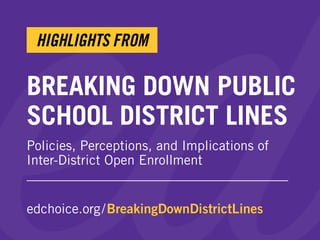Breaking Down Public School District Lines
- 1. BREAKING DOWN PUBLIC SCHOOL DISTRICT LINES Policies, Perceptions, and Implications of Inter-District Open Enrollment edchoice.org/BreakingDownDistrictLines HIGHLIGHTS FROM
- 2. edchoice.org The Bad News: Using district lines to determine where a child goes to school is a 200-year-old mistake that has resulted in racial and socioeconomic segregation in U.S. public schools.
- 3. edchoice.org The Good News: Many states have created open enrollment laws that break down those district lines and allow kids to attend public schools outside their ZIP Code-assigned schools.
- 4. edchoice.org There are two types of open enrollment policies. Intra-district allows kids to attend schools within their assigned district that may not necessarily be their assigned school. Inter-district allows kids to attend schools outside their assigned school and district. (Think interstate, itŌĆÖs a road helping you cross state lines.) ŌĆó ŌĆó
- 5. edchoice.org Every state handles these types of school choice options differently. Some have it ALL. Some have NONE.
- 6. edchoice.org EdChoice partnered with Hanover Research to conduct a series of research projects around inter-district open enrollment and how they effect students and school leaders. Author and researcher Susan Pendergrass breaks it down into this capstone report.
- 7. edchoice.org WHAT DID WE LEARN?
- 8. edchoice.org Public school enrollment in the U.S. has been steadily drifting away from ASSIGNED public schools.
- 9. edchoice.org Some states began allowing families to choose schools through open enrollment in the late 1980s, and charter schoolsŌĆöwhich are publicly funded schools that are privately run with slightly less red tape than traditional schoolsŌĆöbegan opening in the early 1990s. These options, along with existing public magnet schoolsŌĆöwhich are like publicly funded private schools that specialize in one area like arts or medical sciences etc.ŌĆöand virtual public schools now enroll more than one in 10 public school students.
- 10. edchoice.org Families and students most often choose a public school outside their district because of the academic programming and school culture.
- 11. edchoice.org Participants in the study highlight the importance of giving students a sense of agency and ownership over their own educational path. Other common reasons for open enrollment transfers include: School safety District proximity to parentsŌĆÖ work, home or day care Athletic programs Various school climate aspects ŌĆó ŌĆó ŌĆó ŌĆó
- 12. edchoice.org School district administrators who were interviewed for this project feel competitive pressure from open enrollment and often referenced the need to ŌĆ£retain market shareŌĆØ by attracting students from nearby counties (e.g., from other public school districts, charter schools, private schools).
- 13. edchoice.org Participants from HanoverŌĆÖs qualitative study explain the delicate balance districts must strike between accepting new out-of-district transfers and managing intra-district school choice transfers. Districts regulate inter- and intra- district enrollment mainly based on classroom capacity (i.e., available seats), and they will often use a lottery system that prioritizes certain tiers of applicants, such as in-district residency, on-site school employment, scholarship opportunities or sibling preference.
- 14. edchoice.org From the perspective of students: Open enrollment policies should make it easy for those who wish to transfer to do so.
- 15. edchoice.org So how should policymakers improve open enrollment policies?
- 16. edchoice.org Transportation is one of the greatest barriers for open enrollment students, especially those from low-income families.
- 17. edchoice.org None of the state policies analyzed mandate that receiving districts provide transportation to open enrolled students. Instead, it is the responsibility of the parent/guardian.
- 18. edchoice.org State policies could reimburse parents for transporting their own children, as is done in Wisconsin. Or establishing pick up and drop off ŌĆ£kiss and rideŌĆØ locations that could be shared across multiple districts might improve familiesŌĆÖ transportation options.
- 19. edchoice.org All open enrollment policies should be mandatory.
- 20. edchoice.org States with voluntary open enrollment tend to struggle the most, causing more issues of equity and access.
- 21. edchoice.org For example, both Ohio and Indiana districts have a documented history and public perception of ŌĆ£cherry-pickingŌĆØ students they accept to maintain a high- achieving student body.
- 22. edchoice.org Open enrollment should be offered to all students without conditions.
- 23. edchoice.org A childŌĆÖs disability, past grades or test scores shouldnŌĆÖt prevent them from accessing the services and programs available in other districts through open enrollment.
- 24. edchoice.org Make funding flexible, so district schools receive funding set aside for the open enrollment students who come to their schools.
- 25. edchoice.org If states are going to make ŌĆ£capacityŌĆØ a restriction districts can use to deny open enrollment students, then districts must be mandated and held accountable for transparently reporting their open seats.
- 26. edchoice.org Want to learn more about open enrollment in America? Visit edchoice.org/BreakingDownDistrictLines To share your feedback, email research@edchoice.org


























